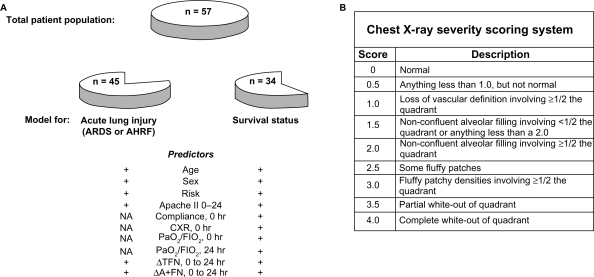Figure 1.
Experimental schema. A) Patient groups. A total population of 57 patients (33 with trauma and 24 with sepsis) was studied via logistic regression analysis of data collected shortly after admission to the ICU. No patient within this group, designated by the intact “pie” at the top of the panel, had ARDS or AHRF upon ICU admission. For the purpose of determining logistic regression models for progression to acute lung injury (ARDS or AHRF), a subsample of 45 patients was studied (pie remnant to the lower left). For analysis of survival, a group of 34 patients, each of whom was also included in the 45 patient subsample cited above, was analyzed (pie remnant to the lower right) (inclusion criteria for each patient subsample are described in Methods). Demographic and physiologic parameters, as well as changes in concentrations of TFN and A+FN are included in the list of potential predictors available for inclusion in logistic regression models for the prediction of acute lung injury or survival. B) Chest x-ray scoring system. Each chest x-ray was divided into quadrants, each of which was scored according to criteria described in the right panels. The resulting quadrant scores were summed and divided by 4 to yield a composite chest x-ray severity score.

